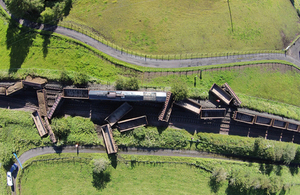Report 13/2016: Freight train collision near Logan, East Ayrshire
RAIB has today released its report into a freight train collision near Logan, East Ayrshire, 1 August 2015.

Aerial image of the accident site (image courtesy of Network Rail)
Summary
On 1 August 2015 at about 11:11 hrs, a freight train travelling within a work site collided with the rear of a stationary freight train at 28 mph (45 km/h).
Engineering staff had authorised the driver of the moving freight train to enter the work site at New Cumnock station, travel about 3 miles (4.8 km) to the start of a track renewal site, and bring the train to a stand behind the stationary train.
There were no injuries but the locomotive and seven wagons from the moving train and eleven wagons from the stationary train were derailed; the locomotive and derailed wagons were damaged. One wagon came to rest across a minor road. There was also substantial damage to the track on both railway lines.
The immediate cause was that the moving train was travelling too fast to stop short of the rear of the stationary train when its driver first sighted the train ahead. This was due to a combination of the train movement in the work site not taking place at the default speed of 5 mph (8 km/h) or at caution, as required by railway rules, and the driver of the moving train believing that the stationary train was further away than it actually was.
An underlying cause was that drivers often do not comply with the rules that require movements within a work site to be made at a speed of no greater than 5 mph (8 km/h) or at caution.
Recommendations
As a consequence of this investigation, RAIB has made four recommendations addressed to freight operating companies.
One relates to the monitoring of drivers when they are driving trains within possessions and work sites.
Two recommendations relate to implementing a method of formally recording information briefed to drivers about making train movements in possessions and work sites.
A further recommendation relates to investigating the practicalities of driving freight trains in possessions and work sites for long distances at a speed of 5 mph (8 km/h) or at other slow speeds, and taking action to address any identified issues.
RAIB has also identified three learning points including:
- the importance of providing drivers with all of the information they need to carry out movements in possessions and work sites safely
- a reminder to provide drivers (before they start a driving duty) with information about how and when they will be relieved
- the importance of engineering staff giving instructions to drivers through a face to face conversation when it is safe and practicable to do so.
On publication of RAIB’s report concerning a freight train collision near Logan, East Ayrshire Simon French, Chief Inspector of Rail Accidents, said:
“Collisions between trains within a work site create the potential for very serious harm to those involved, major damage and days of disruption to the travelling public. I believe that our report on the collision near Logan will provide an important insight into the types of issues that need to be addressed if the risk is to be more effectively managed.
“Train movements within work sites and possessions are not regulated by normal railway signalling systems – which is why special care is needed to make sure that trains are always able to stop in the distance that the driver can see to be clear, and that communications between drivers and engineering staff are precise and mutually understood.
“In the past ten years there have been six significant collisions between trains in work sites. A number of recommendations have been made by RAIB to address the ways that movements of trains in work sites are regulated, and ways of ensuring clear and accurate communications. Although I am disappointed that these recommendations have not yet led to substantive action to fix the problem, I am encouraged to see that the railway industry has now decided to reconsider some of the issues.
“Driving heavy freight trains over long distances within a work site or possession, and ensuring that the train can stop in the distance seen to be clear, is a very different challenge to driving a freight train on an open line. ‘Line of sight driving’ at speeds above 5 mph requires high levels of discipline and concentration, as well as detailed knowledge of the line ahead so that drivers do not find themselves travelling too fast. I hope that RAIB’s recommendations will lead to a careful evaluation of:
- what practical steps can be taken to reduce the lengths of worksites
- the skills needed to drive freight trains over long distances without the protection of signals in work sites and possessions
- the human factors that may influence the behaviour of drivers and their ability to drive trains at an appropriate speed in work sites and possessions
- ways of monitoring the performance of drivers when driving in work sites and possessions
- ways of conveying important information to drivers when entering work sites and possessions so as to minimise the risk of confusion and misunderstandings.”
Notes to editors
- The sole purpose of RAIB investigations is to prevent future accidents and incidents and improve railway safety. RAIB does not establish blame, liability or carry out prosecutions.
- RAIB operates, as far as possible, in an open and transparent manner. While our investigations are completely independent of the railway industry, we do maintain close liaison with railway companies and if we discover matters that may affect the safety of the railway, we make sure that information about them is circulated to the right people as soon as possible, and certainly long before publication of our final report.
- For media enquiries, please call 01932 440015.